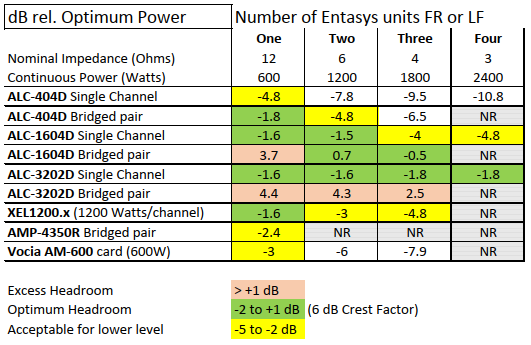Powering ENTASYS ENT-FR/LF loudspeakers
Community ENTASYS ENT-RF and ENT-LF are high performance column line source loudspeakers. As with any speaker, choosing the correct amplifier to power it is critical. This article discusses the considerations involved in selecting an appropriate amplifier to use for powering ENTASYS ENT-FR/LF loudspeakers.
Amplifier power
The ENTASYS ENT-FR and -LF are rated at 600 Watts continuous at 12 Ohms, which works out to 85 Volts RMS. Since the power rating is established using shaped pink noise with a 6 dB crest factor, this means peaks of 170 Volts. When multiple ENTASYS units are stacked, they are wired in parallel and have the same voltage ratings, but at lower impedance, meaning greater power is drawn.
Using traditional amplifiers, this meant that very large amplifiers were required, usually operated in bridged mono configurations. Today’s digital power amplifiers can provide peak voltages much higher than their nominal power rating might suggest. Furthermore, their nominal power rating might remain the same for various impedances, as the power supply throttles and adjusts the amplifier output. This makes it difficult to determine the best amplifier for a particular loudspeaker, especially when the loudspeaker’s impedance is not a standard 4 or 8 Ohms.
How loud will it be?
When SPL requirements are not as high, smaller amplifiers may of course be used. The resultant SPL at a given listener distance cannot be easily extracted by Inverse Squared Distance (6dB/doubling) or Inverse Distance (3 dB/doubling), since the ENTASYS is neither a point source nor an infinite line source. The best way to determine SPL in the audience is by using EASE Focus.
The chart below shows which Community ALC and Biamp amplifiers are suitable for various configurations. For each configuration, it shows the dB relative to the rated power 600 Watts per module with a 6 dB crest factor. In some cases the result is limited by peak voltage, and in other cases it is limited by continuous power throttling of the amplifier. In the latter case, higher crest factor signals such as speech or dynamic music, with their lower continuous demands, may actually pass with higher headroom than suggested here.


